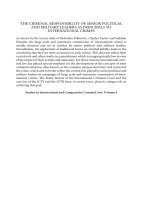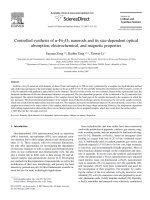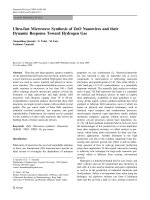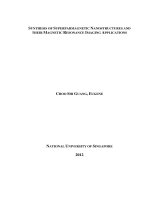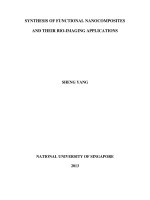Synthesis of crown ether and cyclam capped beta cyclodextrin bonded silica particles and their application as chiral stationary phases in liquid chromatography
Bạn đang xem bản rút gọn của tài liệu. Xem và tải ngay bản đầy đủ của tài liệu tại đây (1.77 MB, 173 trang )
SYNTHESIS OF CROWN ETHER AND CYCLAM-CAPPED
β-CYCLODEXTRIN-BONDED SILICA PARTICLES AND THEIR
APPLICATION AS CHIRAL STATIONARY PHASES IN LIQUID
CHROMATOGRAPHY
BY
GONG YINHAN (M. Sc.)
A THESIS SUBMITTED
FOR THE DEGREE OF DOCTOR OF PHILOSOPHY
DEPARTMENT OF CHEMISTRY
NATIONAL UNIVERSITY OF SINGAPORE
2003
ACKNOWLEGEMENTS
First, I would like to express my sincere gratitude to my supervisor, Professor Lee
Hian Kee. His invaluable guidance, encouragement and patience throughout these years
have been pivotal to the completion of this work.
I gratefully acknowledge an Ang Kok Peng Memorial Fund Scholarship award from
NUS that allowed me to spend study leave at Brigham Young University where the
analytical work on ultra-high pressure capillary liquid chromatography and some
important synthetic work were carried out.
I would like to acknowledge the efforts of all the co-authors and collaborators of
publications related to this work. The main co-authors include Professor Milton L. Lee,
Professor Jerald S. Bradshaw, Dr Xue Guoping and Ms Xiang Yangqiao of Brigham
Young University. I would like to thank the staff of the infrared spectroscopy, elemental
analysis, honours and chromatography laboratories of National University of Singapore
for their technical assistance.
Words cannot describe my thanks and appreciation to my family - especially my
wife Ruan Yang - for their unending concern and support.
i
TABLE OF CONTENTS
ACKNOWLEDGEMENTS
TABLE OF CONTENTS
LIST OF ABBREVIATIONS AND SYMBOLS
PUBLICATIONS
SUMMARY
CHAPTER 1. INTRODUCTION
1.1 Historical Development of Liquid Chromatography and Chiral Liquid
Chromatography
1.1.1 Liquid Chromatography
1.1.2 Chiral Liquid Chromatography
1.2 Recent Applications of Chiral Liquid Chromatography with Chiral
Stationary Phase-packed Columns
1.2.1 High-performance Liquid Chromatography
1.2.2 Ultra-high Pressure Capillary Liquid Chromatography
1.2.3 Capillary Electrochromatography
1.3 Recent Developments in the Synthesis of Bonded Chiral Stationary
Phases for Liquid Chromatography
1.3.1 Types of Chiral Stationary Phases for Liquid Chromatography
1.3.2 Preparation of β-Cyclodextrin Type of Chiral Stationary Phases
i
ii
xi
xiv
xvii
1
1
1
3
5
5
6
7
9
9
10
ii
1.4 General Objectives
1.5 References
CHAPTER 2. SYNTHESIS OF CROWN ETHER AND CYLCAM-CAPPED
β
-
CYCLODEXTRIN-BONDED CHIRAL STATIONARY PHASES
2.1 Introduction
2.2 Results and Discussion
2.3 Experimental
2.3.1 Reagents and Materials
2.3.2 Synthesis of β-CD-bonded Silica Particles CD-HPS, NCCD-HPS and
BACD-HPS
2.3.2.1 Preparation of (3-(β-Cyclodextrin)-2-hydroxypropoxy)-
propylsilyl-appended Silica Particles
2.3.2.2 Preparation of Naphthylcarbamate-substituted (3-(β-
Cyclodextrin)-2-hydroxypropoxy)-propylsilyl-appended Silica
Particles
2.3.2.3 Preparation of Bromoacetate-substituted (3-(β-Cyclodextrin)-2-
hydroxypropoxy)-propylsilyl-appended Silica Particles
2.3.3 Synthesis of Crown Ether-capped β-CD-bonded Silica Particles
AB15C5-CD-HPS, AB18C6-CD-HPS, AQ2D18C6-CD-HPS and
AQ7D18C6-CD-HPS
2.3.3.1 Preparation of Aminobenzo-15-crown-5-capped (3-(β-
13
15
22
22
25
33
33
34
34
35
36
37
iii
Cyclodextrin)-2-hydroxypropoxy)-propylsilyl Silica Particles
2.3.3.2 Preparation of Aminobenzo-18-crown-6-capped (3-(β-
Cyclodextrin)-2-hydroxypropoxy)-propylsilyl Silica Particles
2.3.3.3 Preparation of 8-Aminoquinoline-2-ylmethyl Diaza-18-crown-6-
capped (3-(β-Cyclodextrin)-2-hydroxypropoxy)-propylsilyl Silica
Particles
2.3.3.4 Preparation of 8-Aminoquinoline-7-ylmethyl Diaza-18-crown-6-
capped (3-(β-Cyclodextrin)-2-hydroxypropoxy)-propylsilyl Silica
Particles
2.3.4 Synthesis of Crown Ether-bonded Silica Particles AB15C5-PS and
AB18C6-PS
2.3.4.1 Preparation of 3-(4′-Aminobenzo-15-crown-5)-propylsilyl-
appended Silica Particles
2.3.4.2 Preparation of 3-(4′-Aminobenzo-18-crown-6)-propylsilyl-
appended Silica Particles
2.3.5 Synthesis of Cyclam-capped β-CD-bonded Silica Particles MCCD-HPS
and DCCD-HPS
2.3.5.1 Preparation of Monosubstituted Cyclam-capped (3-(β-
Cyclodextrin)-2-hydroxypropoxy)-propylsilyl-appended Silica
Particles
2.3.5.2 Preparation of Disubstituted Cyclam-capped (3-(β-Cyclodextrin)-
2-hydroxyproxy)-propylsilyl-appended Silica Particles
37
37
38
38
39
39
39
40
40
40
iv
2.3.6 Fourier-transform Infrared (FTIR) Spectroscopic Analysis of the Bonded
Silica Particles
2.4 Concluding Remarks
2.5 References
CHAPTER 3. APPLICATON OF CD-HPS AND NCCD-HPS AS CHIRAL
STATIONARY PHASES FOR HIGH-PERFORMANCE LIQUID
CHROMATOGRAPHY
3.1 Introduction
3.2 Experimental
3.2.1 Reagents and Materials
3.2.2 Apparatus
3.2.3 Preparation of Bonded Stationary Phases
3.2.4 Chromatographic Procedure
3.3 Results and Discussion
3.3.1 Chromatographic Performance of the Columns Packed with CD-HPS
and NCCD-HPS
3.3.1.1 Retention and Separation of Disubstituted Benzenes under
Reversed-phase Conditions
3.3.1.2 Influence of Mobile Phase pH on the Retention of Disubstituted
Benzenes
3.3.2 Enantiomeric Separation of Aromatic Compounds on NCCD-HPS-
40
48
49
52
52
54
54
54
55
55
56
56
56
61
v
packed Column
3.3.2.1 Retention and Enantioseparation under Normal Phase Conditions
3.3.2.2 Influence of the Buffer Content on Enantioseparations on NCCD-
HPS under Reversed-phase Conditions
3.3.2.3 Influence of Mobile Phase pH on Enantioseparations on NCCD-
HPS
3.4 Concluding Remarks
3.5 References
CHAPTER 4. APPLICATION OF CROWN ETHER-CAPPED
β
-
CYCLODEXTRIN-BONDED PARTICLES AB15C5-CD-HPS AND
AB18C6-CD-HPS AS CHIRAL STATIONARY PHASES FOR
ENANTIOSEPARATIONS BY CAPILLARY
ELECTROCHROMATOGRAPHY
4.1 Introduction
4.2 Experimental
4.2.1 Reagents and Materials
4.2.2 Apparatus
4.2.3 Preparation of Bonded Stationary Phases
4.2.4 Preparation of the Packed Capillary Columns
4.2.5 Chromatographic Procedure
4.3 Results and Discussion
62
62
64
67
69
71
73
73
76
76
76
77
78
80
81
vi
4.3.1 Enantioseparations under Acetonitrile/Tris-HCl Running Buffer
Conditions
4.3.1.1 Influence of Acetonitrile Content in Running Buffer on the
Enantiomeric Separations
4.3.1.2 Van Deemter Plot for the Column Packed with AB15C5-CD-
HPS
4.3.1.3 Enantiomeric Separations on Crown Ether-capped β-CD-bonded
Silica Packed-columns Using Acetonitrile/Tris-HCl as Running
Buffer
4.3.2 Enantioseparations under Acetonitrile/Phosphate Running Buffer
Conditions
4.3.2.1 Effects of Electroosmotic Flow under Acetonitrile/Phosphate
Running Buffer
4.3.2.2 Enantiomeric Separations Using Acetonitrile/Phosphate Running
Buffer
4.3.3 Comparison of Enantioseparations between the Columns Packed with
AB15C5-CD-HPS and AB18C6-CD-HPS
4.3.4 Comparison of Enantioseparations among the Columns Packed with β-
CD-bonded Silica Particles, Crown Ether-bonded Silica Particles and
Crown Ether-capped β-CD-bonded Silica Particles
4.4 Concluding Remarks
4.5 References
81
81
83
84
92
92
94
95
98
99
101
vii
CHAPTER 5. APPLICATION OF CYCLAM-CAPPED
β
-CYCLODEXTRIN-
BONDED PARTICLES M14C4-CD-HPS AND D14C4-CD-HPS AS
CHIRAL STATIONARY PHASES FOR CAPILLARY
ECLECTROCHROMATOGRAPHY
5.1 Introduction
5.2 Experimental
5.2.1 Reagents and Materials
5.2.2 Apparatus
5.2.3 Preparation of Bonded Stationary Phases
5.2.4 Preparation of the Packed Capillary Columns
5.2.5 Chromatographic Procedure
5.3 Results and Discussion
5.3.1 Enantioseparations under Tris-HCl Running Buffer Conditions
5.3.1.1 Van Deemter Plot for the Column Packed with MCCD-HPS
5.3.1.2 Influence of Acetonitrile Content in Running Buffer on the
Enantioseparations
5.3.1.3 Comparison of Enantioseparations under Methanol/Tris-HCl and
Acetonitrile/Tris-HCl Running Buffer Conditions
5.3.1.4 Enantiomeric Separations on Crown Ether-capped β-CD-bonded
Silica Packed-columns under Tris-HCl Running Buffer
Conditions
5.3.2 Enantioseparations under Acetonitrile/Tris-HCl-Ni(ClO
4
)
2
Running
104
104
107
107
107
107
108
109
109
109
109
111
112
114
viii
Buffer Conditions
5.3.2.1 Effects of Concentration of Ni
2+
5.3.2.2 Enantiomeric Separations Using Acetonitrile/Tris-HCl-Ni(ClO
4
)
2
as Running Buffer
5.3.3 Comparison of Enantioseparations between the Columns Packed with
Crown Ether-capped β-CD-bonded Phases and Cyclam-capped β-CD-
bonded Phases
5.4 Concluding Remarks
5.5 References
CHAPTER 6. APPLICATION OF CROWN ETHER-CAPPED
β
-
CYCLODEXTRIN-BONDED PARTICLES AQ2D18C6-CD-HPS AND
AQ7D18C6-CD-HPS AS CHIRAL STATIONARY PHASES FOR UTRA-
HIGH PRESSURE CAPILLARY LIQUID CHROMATOGRAPHY
6.1 Introduction
6.2 Experimental
6.2.1 Reagents and Materials
6.2.2 Apparatus
6.2.3 Preparation of Bonded Stationary Phases
6.2.4 Chromatographic Procedure
6.3 Results and Discussion
6.3.1 Column Evaluation
122
122
123
124
128
129
131
131
133
133
134
136
136
137
137
ix
6.3.2 Separation of o,m,p-Nitroaniline
6.3.3 Effect of Sample Injection Amount on Enantioseparation Resolution
6.3.4 Enantioseparations on the Columns Packed with AQ2D18C6-CD-HPS
and AQ7D18C6-CD-HPS
6.3.5 Comparison of Enantioseparations between the Columns Packed with
AQ2D18C6-CD-HPS and AQ7D18C6-CD-HPS
6.4 Concluding Remarks
6.5 References
CONCLUSIONS AND FUTURE WORK
138
140
141
146
147
148
151
x
LIST OF ABBREVIATIONS AND SYMBOLS
AB15C5-CD-HPS
aminobenzo-15-crown-5-capped (3-(β-cyclodextrin)-2-
hydroxypropoxy)-propylsilyl-appended silica
AB18C6-CD-HPS
aminobenzo-18-crown-6-capped (3-(β-cyclodextrin)-2-
hydroxypropoxy)-propylsilyl-appended silica
AB15C5-PS
3-(4′-aminobenzo-15-crown-5)-propylsilyl-appended silica
AB18C6-PS
3-(4′-aminobenzo-18-crown-6)-propylsilyl-appended silica
AQ2D18C6-CD-
HPS
8-aminoquinoline-2-ylmethyl diaza-18-crown-6-capped (3-(β-
cyclodextrin)-2-hydroxypropoxy)-propylsilyl-appended silica
AQ7D18C6-CD-
HPS
8-aminoquinoline-7-ylmethyl diaza-18-crown-6-capped (3-(β-
cyclodextrin)-2-hydroxypropoxy)-propylsilyl-appended silica
BACD-HPS
bromoacetate substituted (3-(β-cyclodextrin)-2-
hydroxypropoxy)-propylsilyl-appended silica
CD-HPS
(3-(β-cyclodextrin)-2-hydroxypropoxy)-propylsilyl-appended
silica
DCCD-HPS
disubstituted cyclam-capped (3-(β-cyclodextrin)-2-
hydroxypropoxy)-propylsilyl-appended silica
MCCD-HPS
monosubstituted cyclam-capped (3-(β-cyclodextrin)-2-
hydroxypropoxy)-propylsilyl-appended silica
NCCD-HPS
naphthylcarbamate substituted (3-(β-cyclodextrin)-2-
hydroxypropoxy)-propylsilyl-appended silica
β-CD β-cyclodextrin
CEC capillary electrochromatography
CSP chiral stationary phase
GC gas chromatography
HPLC high performance liquid chromatography
xi
H plate height
h reduced plate height
i.d. column inner diameter
kV kilovolt
LC liquid chromatography
o.d. column outer diameter
UV ultraviolet
UHPLC ultra-high pressure capillary liquid chromatography
m/z
mass to charge ratio
v /v volume to volume ratio
A
dimensionless coefficient for multipath dispersion
B
dimensionless coefficient for longitudinal band dispersion
C
dimensionless coefficient for resistance to mass transfer
C
m
dimensionless coefficient for resistance to mass transfer in
mobile phase
C
s
dimensionless coefficient for resistance to mass transfer in
stationary phase
D
m
solute diffusion coefficient in the mobile phase
D
s
solute diffusion coefficient in the stationary phase
d
f
stationary phase film thickness
d
p
particle diameter
g gram
k
retention factor
k
1
retention factor of the first component
xii
k
2
retention factor of the second component
m
meter
mV millivolt
N
theoretical plate number (column efficiency)
R
S
resolution
t
M
hold-up time
t
R
retention time
t
R1
retention time of the first component
t
R2
retention time of the second component
α
separation factor
α
c
surface concentration
η
viscosity of the mobile phase
λ
structural factor of the packing material
γ
tortuosity factor for packing material
θ
tortuosity factor for porous particles
µA
microampere
µL
microliter
µm
micrometer
u
mobile phase linear velocity
v
reduced velocity
xiii
PUBLICATIONS
[1] Y. Gong and H.K. Lee, Application of Cyclam-capped β-Cyclodextrin-bonded Silica
Particles as Chiral Stationary Phase in Capillary Electrochromatography for
Enantiomeric Separations, Anal. Chem. 2003, 75, 1348-1354.
[2] Y. Gong, Y. Xiang, B. Yue, G. Xue, J.S. Bradshaw, H.K. Lee and M.L. Lee,
Application of Substituted-diaza-18-crown-6-capped β-Cyclodextrin-bonded Silica
Particles as Chiral Stationary Phase for Ultrahigh Pressure Capillary Liquid
Chromatography, J. Chromatogr. A 2003, 1002, 63-70.
[3] Y. Gong
and H.K. Lee, Application of Naphthylcarbamate-substituted β-
Cyclodextrin-bonded Silica Particles as Stationary Phase for High-performance
Liquid Chromatography, J. Sep. Sci. 2003, 26, 515-520.
[4] Y. Gong and H.K. Lee, Enantiomeric Separations in Capillary Electrochromatography
with Crown Ether-capped β-Cyclodextrin-bonded Silica Particles as Chiral Stationary
Phase, Helv. Chim. Acta 2002, 85, 3283-3293.
[5] Y. Gong, G. Xue, Y. Xiang, J.S. Bradshaw, M.L. Lee and H.K. Lee, Synthesis of
Cyclam-capped β-Cyclodextrin-bonded Silica Particles for Use as Chiral Stationary
Phases in Capillary Electrochromatography, Tetrahedron Lett. 2002, 43, 2463-2466.
[6] Y. Gong, G. Xue, J.S. Bradshaw, M.L. Lee and H.K. Lee, Synthesis of Crown Ether-
capped 3-(β-Cyclodextrin)-2-hydroxypropylsilyl-appended Silica Particles for Use as
Chiral Stationary Phases in Chromatography, J. Heterocycl. Chem. 2001, 38, 1317-
1321.
xiv
[7] Y. Gong
and H. K. Lee, Enantiomeric Separations by Capillary Electro-
chromatography Using 4'-Amiobenzo-15-crown-5 capped 3-(β-Cyclodextrin)-2-
hydroxypropylsilyl Silica as Chiral Stationary Phase, presented at the 24
th
International Symposium on Capillary Chromatography & Electrophoresis (Las
Vegas, NV, USA, May 2001). Extended paper abstract was published at:
[8] Y. Gong, Y. Xiang, B. Yue, G. Xue, J. S. Bradshaw, H. K. Lee and M. L. Lee,
Application of 8-Aminoquinoline-2-ylmethyl-substituted Diaza-18-crown-6-capped
3-(β-Cyclodextrin)-2-hydroxypropylsilyl Silica as Chiral Stationary Phase for
Ultrahigh Pressure Capillary Liquid Chromatography, presented at the 24
th
International Symposium on Capillary Chromatography & Electrophoresis (Las
Vegas, NV, USA, May 2001). Extended paper abstract was published at:
[9] Y. Gong, Y. Xiang, G. Xue, J. S. Bradshaw, M. L. Lee and H. K. Lee, Application of
Crown Ether-capped β-Cyclodextrin-bonded Chiral Stationary Phases in CEC and
UHPLC, presented at Frontiers in Separation and Purification Symposium (Singapore,
October 29-30, 2001).
[10] Y. Gong
and H. K. Lee, Synthesis of Crown Ether-capped β-CD-bonded Silica and
Their Application as Chiral Stationary Phases in Liquid Chromatography, presented
at the 2
nd
Singapore International Chemical Conference (Singapore, December 18-20,
2001).
[11] Y. Gong and H. K. Lee, Application of Crown Ether/Cyclam-capped β-
Cyclodextrin-bonded Silica as Chiral Stationary Phases in Capillary
xv
Electrochromatopgraphy for Enantioseparations, presented at the 15
th
International
Symposium on Microscale Separations and Analysis (Stockholm, Sweden, April 13-
18, 2002).
xvi
SUMMARY
Separating chiral molecules is one of the most active areas of analytical chemistry.
Chromatographic methods are typically employed for enantioseparations by using chiral
stationary phases (CSPs) or adding chiral selectors into mobile phases. This research
focuses on synthesizing a series of new types of β-cyclodextrin (β-CD)-bonded silica
particles and crown ether/cyclam-capped β-CD-bonded silica particles and using these
new materials as CSPs in conventional high-performance liquid chromatography (HPLC),
ultra-high pressure capillary liquid chromatography (UHPLC) and capillary
electrochromatography (CEC) to develop enantioseparation techniques with high
enantioselectivity and high resolution.
Crown ether/cyclam-capped β-cyclodextrin-bonded silica particles are a new type
of bonded CSPs that have a chiral selector with several recognition sites: β-CD, crown
ether/cyclam and the latter’s side arm. This CSP was prepared by using a successive
multiple-step liquid-solid phase reaction on the silica gel surface: β-CD was anchored
onto silica support, derivatized by treatment with bromoacetyl bromide, and finally
reacted with several kinds of amine-containing crown ethers/cyclams. The bonded silica
particles were characterized by means of elemental analysis and Fourier transform
infrared spectroscopy. Using a slurry packing method, some of the β-CD-bonded CSPs
were packed into commercially available stainless steel tubes for application in HPLC,
and the crown ether/cyclam-capped CSPs were packed into fused silica capillary tubing
to fabricate capillary columns for application in UHPLC and CEC. The separation
xvii
selectivities of those CSPs were examined by separating positional isomers of
disubstituted benzenes and stereoisomers of chiral compounds under both normal phase
and reversed-phase conditions in HPLC and UHPLC. The enantioselectivity and column
efficiency for columns packed with some bonded CSPs were also evaluated in CEC
under several running buffer conditions.
Enantioseparations for a wide range of chiral compounds were achieved on the
columns packed with those crown ether/cyclam-capped β-CD-bonded CSPs in UHPLC
and CEC. This type of CSPs has excellent enantioselectivity due to the multiple solute-
stationary phase interactions possible and the co-operative function of crown
ether/cyclam and β-CD. After inclusion of the metal ion from the mobile phase into the
crown ether/cyclam unit, the CSPs become positively charged. The positively charged
crown ether/cyclam-capped β-cyclodextrins can supply extra electrostatic interaction
with ionizable solutes and enhance the dipolar interactions with some polar neutral
solutes. This enhances the host-guest interaction with some solutes and improves chiral
recognition and selectivity. Application of this new type of CPSs in CEC was shown as a
powerful enantioseparation technique with high enantioselectivity and high column
efficiency. Fast enantioseparations with high resolution were easily achieved when two
kinds of aminoquinoline-containing diaza-18-crown-6-capped β-CD-bonded nonporous
CSPs were used in UHPLC.
The results showed that the crown ether/cyclam-capped β-CD type-bonded CSPs
were synthesized using a convenient successive multiple-step liquid-solid phase reaction
on the silica gel surface. Those CSPs have shown excellent enantioselectivity due to their
special structure. Accordingly, they would have strong potentials for fast
xviii
enantioseparations with high efficiency and high resolution when using as chiral
stationary phases in UHPLC and CEC.
xix
CHAPTER 1
INTRODUCTION
1.1
HISTORIAL DEVELOPMENT OF LIQUID CHROMATOGRAPHY AND CHIRAL
LIQUID CHROMATOGRAPHY
1.1.1 Liquid Chromatography
Liquid chromatography (LC) was invented by M. Tswett one century ago [1-4].
Tswett separated various plant pigments by passing plant extracts through a glass column
filled with different powdered organic and inorganic materials which acted as adsorbents
[3,4]. The different components of a pigment mixture produced separate colored bands on
the calcium carbonate column and inspired the term “chromatography” [1]. Today, this
term is still used to describe the separation techniques that employ a stationary and a
mobile phase [2]. The concept of chromatography relies basically on the distribution of a
compound between these two phases [2,5]. Tswett’s work was largely ignored for several
decades until Martin and Synge first introduced column liquid-liquid partition
chromatography in 1941 [6]. However, it was not until the mid-1960s that high-
performance liquid chromatography (HPLC) assumed a permanent place in
chromatography history. In the last 30 years, tremendous effort has been carried out to
develop and improve the performance of HPLC. This has led to HPLC becoming a
common chromatographic technique for analytical separations. Presently, HPLC is an
increasingly important technique for high throughput analysis of extremely complex
1
samples that are typically encountered in the life science and in environmental analysis
[7].
In HPLC, 3.2─4.6 mm i.d. (internal diameter) stainless steel columns are commonly
employed. The primary reasons for the popularity of HPLC are the ruggedness and ease
of use of these conventional stainless steel columns [2,5]. The potential advantages of
reducing the column diameter to capillary dimension were recognized by
chromatographers almost at the same time as HPLC was introduced [8-11].
Miniaturization is a general trend to science and technology, and the down-scaling of
conventional LC to capillary LC offers the following attractive advantages [12-16]: (1)
capillary LC yields higher efficiency than conventional LC; (2) capillary LC significantly
reduces the cost of operation; (3) Low mobile phase flow rates facilitate direct coupling
with a mass spectrometer and facilitate the coupling with a secondary chromatographic
system to represent multi-dimensional chromatographic systems, such as capillary LC-
supercritial fluid chromatography (SFC), and capillary LC-capillary electrophoresis (CE),
or capillary LC-capillary GC; and (4) capillary LC columns are compatible with small-
size samples, such as those frequently encountered in modern biology, medicine and life
science.
Initial miniaturizing efforts in LC are attributed to Horvath and co-workers in 1969
[17,18]. In the late 1970s, Ishii and co-workers [19-24] reported the slurry packing of 5-
30 cm × 250-500 µm i.d. polytetrafluorothylene (PTFE) columns with 5-30 µm particles
and used these columns to produce separations that compared favourably to those
obtained by conventional HPLC. Shortly after Yang [25] performed capillary LC with
fused silica microparticle-packed columns in 1980s, the highly desirable attributes of
2
fused silica capillary tubing (e.g., mechanical strength, flexibility, and low adsorption)
quickly made it the preferred choice. In the early 1990s, packed fused silica capillary
electrochromatography (CEC) received much attention and developed as a powerful
modern capillary LC technique [26-31]. In 1997, MacNair et al. [32] introduced ultrahigh
pressure capillary liquid chromatography (UHPLC) to overcome the pressure limitations
that small particles impose on conventional HPLC pumping systems. UHPLC is a
modern LC technique that can achieve very high efficiency and resolution [33-35].
1.1.2 Chiral Liquid Chromatography
The optical activity of chiral molecules was first noted by Biot in the early 1800s
and the existence of optical isomers was established by Pasteur in 1848 [36]. The concept
of the asymmetric carbon atom helped Van’t Hoff and Le Bel to explain the existence of
optical isomers and Fisher in the late 1880s determined the configuration of (+)-glucose.
Later, Bijovet confirmed the work of Fisher by X-ray crystallography. After that, work in
the field of enantiomers continued relatively slowly until about 1980 when the selective
physiological activity of the different optical isomers of drugs became recognized.
Nowadays, enantiomeric separation is important in various fields, such as natural product
research, stereospecific synthesis, chiral drug analysis in the pharmaceutical industry and
chiral compound analysis in environmental studies [37]. In the pharmaceutical industry, a
large number of the most frequently prescribed drugs contain one or more chiral centers
and may exist in two or more enantiomeric forms [38]. In most instances, only one of the
enantiomeric forms is therapeutically active, while the other enantiomer is either much
less active, inactive, or sometimes even toxic [39]. At present, it is conceptually accepted
3
that a pair of enantiomers should be treated as two different compounds when exposed to
a biological system. The United States Food and Drug Administration recommends that
each isomer of all new drugs should be individually tested [39]. As the enantiomers have
identical physical properties, they cannot be easily resolved employing the usual
separation techniques such as fractional distillation. Generally, there are two basic
approaches to obtain enantiomers: asymmetric synthesis and enantioseparations [40].
Chemical asymmetric synthesis still remains a favorite route for preparation of
enantiomers, especially when a large amount of a given enantiomer is required. Chiral
chromatography techniques which utilize chiral stationary phases and/or chiral mobile
phases (additives) are successfully employed for enantioseparations, including HPLC
[41], GC [42], SFC [43], micellar electrokinetic capillary chromatography (MEKC) [44]
and, more recently, UHPLC [45] and CEC [46-48].
To improve enantioseparations, two approaches can be used in chromatography: (a)
optimizing chromatographic conditions, and (b) using new chiral stationary phases or
chiral additives in the mobile phase. GC and LC were the first tools employed in the
separation of enantiomers [36]. Although GC usually offers higher efficiencies due to the
larger number of available theoretical plates, most chiral compounds of interest have low
volatilities. This limits the use of this technique for enantioseparations [49]. HPLC has
become a common technique in the pharmaceutical industry for enantioseparations [41].
There are many chiral stationary phases and chiral mobile phase additives widely used in
HPLC for separating chiral drugs. During the last several years, CE has become a
powerful technique for enantioseparations when chiral selectors are added to the running
4
buffers [50]. However, many chiral selectors with high UV/visible absorbance and/or
poor solubility in water are not suitable to be used as CE additives for direct detection.
UHPLC is a modern LC technique with high efficiencies and high resolutions. It is
possible to use long capillary columns to harness the advantage of small nonporous
particles, i.e., high efficiency is achievable with little loss at high linear velocities [45].
High-resolution separations and fast separations are easily obtained. On this basis,
UHPLC has great potential for fast enantiomeric separations when using chiral stationary
phases prepared from small nonporous particles [51].
CEC is another modern packed column LC technique combining the high efficiency
of CE with the high selectivity usually obtained in HPLC. The mobile phase in CEC is
transported through a capillary containing the stationary phase by means of
electroosmosis instead of pressure [52]. Like other electrophoretic techniques, CEC
provides a flat flow profile of the mobile phase and provides the possibility of using
small size particles as stationary phase. This greatly increases efficiencies of separations
[53]. Therefore, using small size particles of new chiral stationary phases with high
selectivity in CEC has received much attention and shown good potential for high-
resolution enantioseparations.
1.2 RECENT APPLICATIONS OF CHIRAL LIQUID CHROMATOGRAPHY
WITH CHIRAL STATIONARY PHASE-PACKED COLUMNS
1.2.1 High-performance Liquid Chromatography
HPLC has been widely used to separate chiral compounds. Various HPLC methods
can be used for chromatographic separation of enantiomers when some kind of chiral
5



